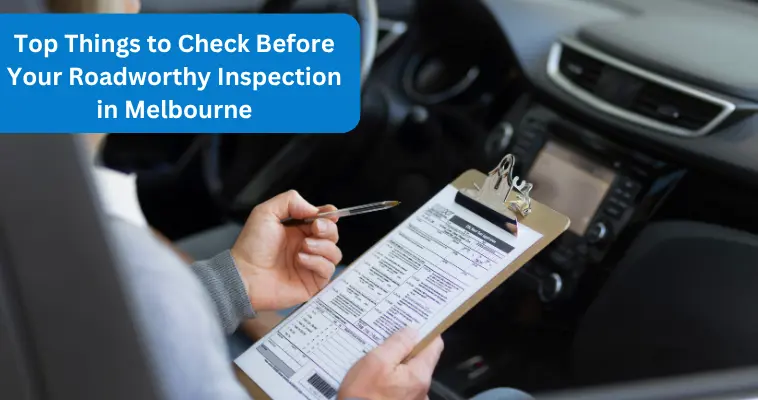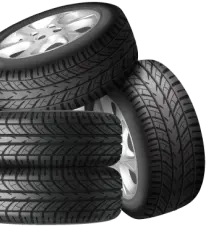Obtaining a roadworthy certificate is a legal requirement in Victoria when selling, re-registering, or transferring ownership of a vehicle. It confirms that your car meets the minimum safety standards to be driven on public roads. For vehicle owners in Melbourne, ensuring your car is properly prepared for a roadworthy inspection can prevent costly delays, rejections, or unexpected repairs.
This blog provides a clear and practical roadworthy checklist to help you understand what’s assessed and how to properly prepare your vehicle. Whether you're selling your car or ensuring compliance with Victorian road safety standards, it’s designed to support an efficient and compliant inspection process.
What are the 10 Things to Check Before Your Roadworthy Inspection?
Before your roadworthy inspection, it's important to check the key parts of your vehicle to ensure it meets the required standards. Here are 10 important things to inspect:
1. Tyres and Wheels
Licensed vehicle inspection begins by inspecting the condition of your tyres and wheels. Make sure the following criteria are met:
- Tyres are not bald, cracked, or unevenly worn.
- Tread depth is at least 1.5 mm across the entire tyre.
- All four tyres match in size and type (especially for cars requiring this for safety compliance).
- Wheels are securely fastened and free from major damage or corrosion.
Tyre condition is important not only for meeting legal requirements but also for ensuring safety—especially in vehicles like BMWs, Audis, and other precision-engineered models. If you’ve noticed vibration, pulling to one side, or irregular tyre wear, it’s worth understanding whether wheel alignment or balancing is the real fix for your driving issues.
2. Brakes
Your braking system must be in working condition to pass a roadworthy test. Inspect:
- Brake pads for wear—most pads should have at least 3mm left.
- Brake discs (or rotors) for deep grooves or warping.
- Brake lights (including the third brake light) to ensure they function properly.
- The handbrake, or parking brake, holds the car stationary without slipping.
However, knowing how often to check and replace your brakes and brake fluid can make a real difference in avoiding costly or complex issues. A soft brake pedal, grinding noise, or delayed stopping could all lead to a failure. If you're unsure, a car service in Melbourne can help spot these issues early.
3. Steering and Suspension
Your vehicle’s steering and suspension directly affect how safely it handles on the road. Before your inspection, check for:
- Excessive play or looseness in the steering wheel.
- Uneven ride height or sagging on one side.
- Unusual noises when turning or going over bumps.
- Leaking shock absorbers or struts.
If you own a vehicle that requires precision alignment—like a Mercedes or Audi—this step is especially important to avoid a failed inspection. Knowing what to consider when deciding between repairing or replacing your suspension can also help you make the right call before issues become more complex.
4. Lights and Electrical Systems
All lights and electrical components must work as intended. This includes:
- Headlights (low and high beam), indicators, lights, and reverse lights.
- Number plate light—commonly overlooked but essential.
- Dash warning lights—if any are lit up, such as engine or ABS warning lights, they must be addressed.
- Windscreen wipers and washers must function effectively and have adequate washer fluid.
5. Windows, Windscreens, and Mirrors
Clear visibility is essential for safe driving and a successful inspection. Ensure your vehicle meets the following requirements:
- Windscreen is free from major chips, cracks, or discolouration in the driver’s line of sight.
- Wipers must be in good condition, free of splits or squeaks.
- Side and rearview mirrors must be secure, not cracked, and provide a clear view.
- Front windows must roll up and down easily and should not be tinted beyond legal limits.
A clear and unobstructed view is a mandatory requirement for obtaining a roadworthy certificate in Melbourne.
6. Seatbelts and Seats
Seatbelts and seats are critical for occupant protection. Make sure:
- Every seatbelt locks, retracts, and latches properly.
- There are no visible frays, tears, or damage on the belts.
- Seats are securely mounted with no movement.
- The driver’s seat adjusts as intended.
If your vehicle was modified with aftermarket seats or belt systems, ensure they comply with Australian safety standards.
7. Body, Chassis, and Rust
The external condition of your vehicle matters more than just looks. Inspect for the following before seeking a roadworthy certificate near you:
- Significant rust, especially on structural parts like the chassis, floor pan, or suspension mounts.
- Sharp edges or panels hanging loose could be a risk.
- Doors, bonnet, and boot close securely without force.
- No fuel leaks or signs of leaking underneath the vehicle.
Minor issues are usually fine, but structural rust or damage can result in a failed inspection.
8. Exhaust System
A functional and secure exhaust system is a must for safety and environmental reasons. Make sure:
- There are no holes or leaks in the exhaust.
- Exhaust is properly mounted and not dragging or rattling.
- Emissions are not excessive (visible smoke or strong smells).
Vehicles modified with aftermarket exhausts must still meet legal noise and emissions standards.
9. Engine and Fluids
A clean, leak-free engine is important not just for performance, but also to meet roadworthy criteria. Make sure to check the following:
- No fluid leaks (oil, coolant, brake fluid, transmission fluid).
- All hoses and belts are in good condition.
- Engine starts cleanly, idles smoothly, and runs without knocking or hesitation.
- Oil and coolant levels are correct.
If your car hasn’t been serviced recently, now is an ideal time—especially for vehicles that require careful inspection to meet roadworthy certificate standards.
10. Compliance with Modifications and Accessories
If you’ve made modifications to your car, such as installing suspension kits, tinted windows, or aftermarket parts, ensure they are compliant with Victorian regulations. The most common issues include:
- Ride height is too low.
- Illegal window tinting.
- Loud exhausts.
- Non-compliant lighting systems (e.g., coloured underglow or LED strips).
For a better understanding, it’s advisable to visit a car mechanic in Melbourne before your roadworthy inspection.
Why Vehicles Fail the Roadworthy Test in Melbourne
Even well-maintained vehicles can fail due to simple oversights. Common reasons include:
- Bald or mismatched tyres
- Leaking fluids
- Malfunctioning lights
- Windscreen damage
- Worn brake pads
Take Away
Preparing for a roadworthy inspection doesn’t have to be stressful. With the right checks, a little maintenance, and a reliable service provider, you can ensure your vehicle is safe and ready for the road.
Here’s what to remember:
- Follow a detailed roadworthy checklist
- Address any minor issues before they become major problems
- Use a trusted, accredited service workshop for inspections and repairs
- Don’t wait—give yourself time to fix anything before the test
- Choose mechanics who work with a range of brands—from Toyota to Audi
Whether you're looking for an Audi service in Melbourne or need an experienced car mechanic, BCS Workshop provides vehicle maintenance, flexible payment options, and nationwide warranty coverage.









